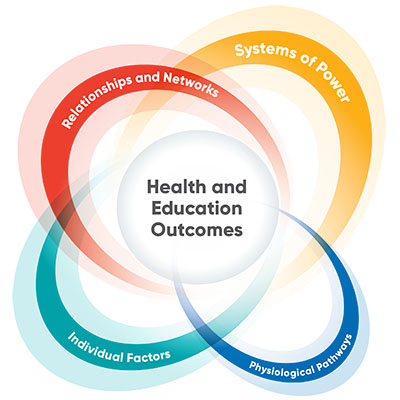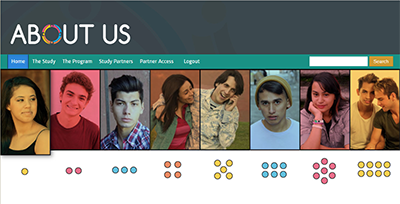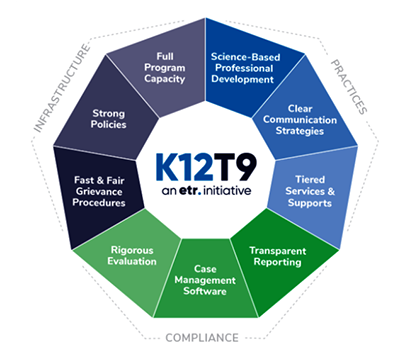Educational Equity IS Health Equity
By Amy Peterson, MSc | April 25, 2019
Strategic Development Manager, ETR
Educational equity is closely related to health equity. In fact I’d like to suggest that they are essentially inseparable—that educational equity isn’t merely an element of health equity, but that the two are inextricably linked. Put simply, one cannot exist without the other.
In 2014, I was among a group of colleagues who sought out a framework that would help us unify the work we were doing across ETR’s projects. We found that no existing framework covered all the aspects of our work so we adapted, developed and iterated to create ETR’s Health Equity Framework (HEF). At the center of the HEF is our belief that health includes our physical, mental, spiritual and social well-being. Closely linked to that well-being is the social, economic and educational equity of our communities and society.
We are doing a great deal to explore this relationship between education and health equity.
Education and Health
The link between education and health has long been established. People who have more years of schooling are more likely to live longer and have better health outcomes throughout their life. But why is this?
The Center on Society and Health at Virginia Commonwealth University highlights ways that education enables and leads to better health outcomes:
- Increased access to income and resources. People with more education are more likely to have jobs with benefits that promote health (e.g., health insurance and retirement). They tend to have higher earnings that allow families to access resources, such as stable housing, health care and healthy foods.
 Improved social and psychological benefits. People with less education tend to experience more stress associated with economic and social disadvantage, such as discrimination based on race, gender, sexual orientation and other identities. People with more education are more likely to be buffered from the effects of stress. They tend to have additional social networks that can provide financial, psychological and emotional support.
Improved social and psychological benefits. People with less education tend to experience more stress associated with economic and social disadvantage, such as discrimination based on race, gender, sexual orientation and other identities. People with more education are more likely to be buffered from the effects of stress. They tend to have additional social networks that can provide financial, psychological and emotional support.
Education can also help build greater social and emotional skills that support a person’s ability to navigate and manage challenges affecting health and well-being.
- Increased access to health education. Education supports the development of increased health literacy skills—skills that help people advocate for their health and the health of their families.
- Increased access to highly-resourced neighborhoods. People with more education and higher paying positions are able to live in neighborhoods with greater access to healthy food options, green spaces, health care providers and higher-paying jobs. These neighborhoods also tend to have higher-resourced schools, less pollution and more political influence to advocate for community needs.
So yes, education supports better health. Conversely, health is important for education outcomes. A number of health problems—such as vision, asthma, physical activity and hunger—are known to impact education by impeding sensory perceptions, cognition, school connectedness, attendance and enrollment. Health affects the way students show up to school and interact with their learning and environment.
Another critical link between education and health is that both are influenced by many of the same social, economic and environmental conditions spanning the lifespan, such as discrimination, segregation, institutionalized biases and adverse community experiences. The cumulative experiences from early childhood through adolescence and into adulthood affect the opportunities for success in education and better health.
Education and ETR’s Health Equity Framework
 All these influences and relationships show up in ETR’s Health Equity Framework. The Health Equity Framework helps us understand the ways health is influenced by people and their environments, summarized in four interacting spheres of influence: Systems of Power, Relationships and Networks, Individual Factors and Physiological Pathways.
All these influences and relationships show up in ETR’s Health Equity Framework. The Health Equity Framework helps us understand the ways health is influenced by people and their environments, summarized in four interacting spheres of influence: Systems of Power, Relationships and Networks, Individual Factors and Physiological Pathways.
The relationship between education and health is a perfect example of how these influences interact to impact people’s physical, social and emotional well-being. Here are some of the ways we have been exploring this relationship.
Four Interacting Spheres of Influence
- Relationships and Networks. Connections with family, friends, partners, community, school and workplaces.
- Individual Factors. A person’s response to social, economic and environmental conditions.
- Systems of Power. Policies, processes and practices.
- Physiological Pathways. Physical, cognitive and psychological functions.
School-based health and wellness centers
ETR has a long history working with school-based health and wellness centers (SBHWC)—an eloquent integration of school and health. SBHWC address the HEF’s Systems of Power sphere by providing students and others in the school community with easy and affordable access to physical and mental health services.
 SBHWC are known to have numerous positive effects on students. For example, findings from our long-term partnership with the San Francisco Unified School District have shown that students who use services from school health and wellness centers have better attendance, develop positive relationships with staff and do better and are more engaged in school.
SBHWC are known to have numerous positive effects on students. For example, findings from our long-term partnership with the San Francisco Unified School District have shown that students who use services from school health and wellness centers have better attendance, develop positive relationships with staff and do better and are more engaged in school.
SBHWC are also uniquely positioned to reach young people through specific interventions. In addition to meeting young people where they are physically (that is, in school), SBHWC are designed to build trust and meet young people where they are developmentally.

Educational equity and computer science
 ETR’s Equity & Inclusion in STEM team has built partnerships with tech companies and educational institutions to explore ways to strengthen students’ engagement and persistence in technology fields. Projects have spanned middle school to early adulthood. Supporting the success of students in STEM education can lead to more careers for underrepresented groups in these fields, increasing their access to higher income, better health care and other resources that support health.
ETR’s Equity & Inclusion in STEM team has built partnerships with tech companies and educational institutions to explore ways to strengthen students’ engagement and persistence in technology fields. Projects have spanned middle school to early adulthood. Supporting the success of students in STEM education can lead to more careers for underrepresented groups in these fields, increasing their access to higher income, better health care and other resources that support health.
Recently, we published results from a qualitative study on the institutional barriers and potential solutions for achieving a computer science (CS) degree. Findings from this study address the HEF’s Systems of Power sphere by providing recommendations to increase equity in college CS programs. For example, colleges can:
- Establish better support for students who experience setbacks in their educational pathways—e.g., financial hardship, family demands that require a break from studies. We see benefits when colleges provide CS-focused counseling to students and offer support to faculty who serve as effective student champions.
- Smooth pathway discontinuities by providing flexibility for working students and easing the difficulty of re-entering college after an absence.
- Discourage pathway departures by offering opportunities for students with various levels of math ability, supporting first-generation college students in navigating college pathways, and exposing students to career outcomes that help them plan their education in more effective and practical ways.
Title IX and sexual- and gender-based harassment
When students experience bullying and discrimination, their mental health, social skills and academic abilities suffer. Unfortunately, the procedures for reporting and resolving harassment often lead to delayed or unresolved complaints, further impacting students’ well-being.
 ETR has expanded our efforts to support schools in eliminating, preventing and addressing sexual- and gender-based harassment through our K12T9 Initiative.This integrated approach addresses school infrastructure, practices and compliance in ways that support young people coming forward with questions or complaints. It also helps schools meet federal requirements.
ETR has expanded our efforts to support schools in eliminating, preventing and addressing sexual- and gender-based harassment through our K12T9 Initiative.This integrated approach addresses school infrastructure, practices and compliance in ways that support young people coming forward with questions or complaints. It also helps schools meet federal requirements.
The K12T9 Initiative addresses all four spheres of influence in the HEF by assessing and revising reporting policies and systems (Systems of Power), providing training to improve student-staff relationships (Relationships and Networks), improving systems that enable young people to report harassment (Individual Factors), and implementing practices that align with young people’s development (Physiological Pathways).
Recently, we released comments on Title IX regulations based on our extensive experience partnering with K-12 schools. These comments outline the ways in which Title IX regulations can be improved so that schools can maintain safe and positive learning environments for their students. For example, schools need policies and guidelines that account for the developmental age (including physical, cognitive and sexual development) of students in formal reports of harassment. It is also vital that schools expand the responsibilities of Title IX reporting to all adults within the school environment, not just Title IX coordinators and teachers.
We look forward to our continued work with schools, Title IX coordinators and others through this initiative.
The Health Equity Framework as a Tool for Change
Our work is based on the idea that health and education outcomes are intrinsically linked. We seek to improve these outcomes collectively and across multiple projects. We developed ETR’s Health Equity Framework to help us, and others, think about improving interrelated outcomes from multiple, overlapping perspectives.
We are excited about the ways we can use the Framework as a tool to consider how structural, relational and individual influences impact health and education outcomes. We invite you to explore the Framework further. Let us know what you think about how we are applying it across projects in health and education. Are these approaches relevant in your own work? Does the Framework offer new insights about the influences affecting the populations you serve?
Amy Peterson is Strategic Development Manager at ETR. She has worked closely with staff and administrations at the school, district, state and local government levels, as well as with researchers, health professionals, social workers and others, to strengthen policies and practices to improve adolescent health. She is currently working towards her PhD in public health at the London School of Hygiene and Tropical Medicine. She can be reached at amy.peterson@etr.org.





